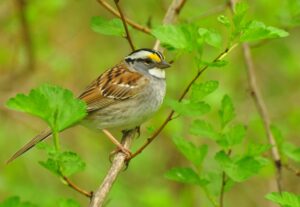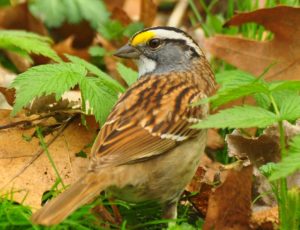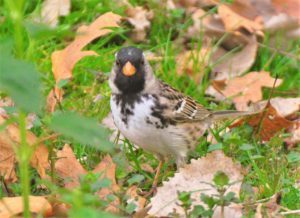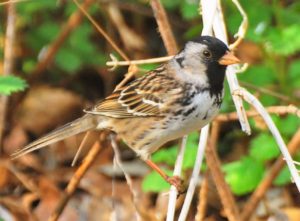Photography courtesy of Lowell Washburn, all rights reserved.
The spring songbird migration is winging northward. And while the larger and more colorful species – such as tanagers, orioles, and grosbeaks – tend to steal the annual show, there are other interesting, though less conspicuous, species that often tend to go unnoticed.

Two of my favorites in this category are the white-throated and Harris’ sparrows. Both species are easy to overlook, partly because they spend the majority of their time foraging beneath the foliage of dense woodland understory.
Exiting the southern wintering grounds via starry, nighttime migrations, the sturdily built white-throated sparrow is one of the first songbird migrants to arrive in Iowa each spring. Marked with a bold of pattern of white and black head striping, bright yellow lores, and distinctive white throat patch, it is one of our easiest birds to identify. While foraging across the forest floor, white-throateds enthusiastically employ both feet to scratch and rake away ground clutter like so many miniature turkeys. Leaves fly as nutrient rich seeds and insects are discovered and eagerly consumed.

White-throated sparrows provide a favored food item for the blue jay-sized sharp-shinned hawks which are also currently moving northward. But there is safety in numbers and migrating sparrows tend to forage in groups. Whenever an unidentified shadow passes overhead communally feeding birds do not flee, but rather exhibit the quail-like habit of flattening to the ground and remaining completely motionless until the danger passes. Once the coast is clear, feeding resumes as if nothing has happened. When viewed at close range, the start and stop foraging activities make for entertaining observations.
Wherever large numbers of foraging white-throated are encountered, you may also have the good fortune of spotting one or two Harris’ sparrows. With its distinctive black bib, black crown, and streaked sides, it would be hard to mistake the Harris’ for any other species. With a length of seven inches, it is the largest and arguably most spectacular, of our native sparrows. Although some Harris’ sparrows occur in Iowa during winter, most spend the cold weather months in the southern U.S. and northern Mexico. Long distance migrants, most Harris’ nest at or above the treeline in subarctic tundra. Harris’ sparrows are the only North American songbird that breeds exclusively in Canada. During the summer nesting season, they are found nowhere else on earth.



 Tom Cope
Tom Cope Sue Wilkinson
Sue Wilkinson Susan Judkins Josten
Susan Judkins Josten Rudi Roeslein
Rudi Roeslein Elyssa McFarland
Elyssa McFarland Mark Langgin
Mark Langgin Adam Janke
Adam Janke Joe Henry
Joe Henry Kristin Ashenbrenner
Kristin Ashenbrenner Joe Wilkinson
Joe Wilkinson Dr. Tammy Mildenstein
Dr. Tammy Mildenstein Sean McMahon
Sean McMahon